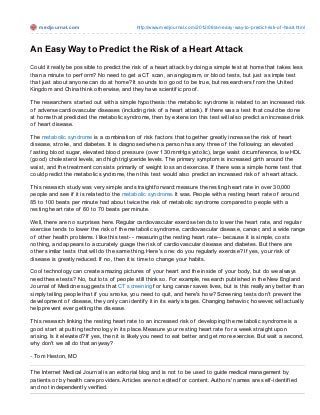
20120803 An Easy Way to Predict the Risk of a Heart Attack
- 1. m e djo urnal.co m http://www.medjo urnal.co m/2012/08/an-easy-way-to -predict-risk-o f-heart.html An Easy Way to Predict the Risk of a Heart Attack Could it really be possible to predict the risk of a heart attack by doing a simple test at home that takes less than a minute to perf orm? No need to get a CT scan, an angiogram, or blood tests, but just a simple test that just about anyone can do at home? It sounds too good to be true, but researchers f rom the United Kingdom and China think otherwise, and they have scientif ic proof . T he researchers started out with a simple hypothesis: the metabolic syndrome is related to an increased risk of adverse cardiovascular diseases (including risk of a heart attack). If there was a test that could be done at home that predicted the metabolic syndrome, then by extension this test will also predict an increased risk of heart disease. T he metabolic syndrome is a combination of risk f actors that together greatly increase the risk of heart disease, stroke, and diabetes. It is diagnosed when a person has any three of the f ollowing: an elevated f asting blood sugar, elevated blood pressure (over 130 mmHg systolic), large waist circumf erence, low HDL (good) cholesterol levels, and high triglyceride levels. T he primary symptom is increased girth around the waist, and the treatment consists primarily of weight loss and exercise. If there was a simple home test that could predict the metabolic syndrome, then this test would also predict an increased risk of a heart attack. T his research study was very simple and straightf orward: measure the resting heart rate in over 30,000 people and see if it is related to the metabolic syndrome. It was. People with a resting heart rate of around 85 to 100 beats per minute had about twice the risk of metabolic syndrome compared to people with a resting heart rate of 60 to 70 beats per minute. Well, there are no surprises here. Regular cardiovascular exercise tends to lower the heart rate, and regular exercise tends to lower the risk of the metabolic syndrome, cardiovascular disease, cancer, and a wide range of other health problems. I like this test-- measuring the resting heart rate-- because it is simple, costs nothing, and appears to accurately guage the risk of cardiovascular disease and diabetes. But there are other similar tests that will do the same thing. Here's one: do you regularly exercise? If yes, your risk of disease is greatly reduced. If no, then it is time to change your habits. Cool technology can create amazing pictures of your heart and the inside of your body, but do we always need these tests? No, but lots of people still think so. For example, research published in the New England Journal of Medicine suggests that CT screening f or lung cancer saves lives, but is this really any better than simply telling people that if you smoke, you need to quit, and here's how? Screening tests don't prevent the development of disease, they only can identif y it in its early stages. Changing behavior, however, will actually help prevent ever getting the disease. T his research linking the resting heart rate to an increased risk of developing the metabolic syndrome is a good start at putting technology in its place. Measure your resting heart rate f or a week straight upon arising. Is it elevated? If yes, then it is likely you need to eat better and get more exercise. But wait a second, why don't we all do that anyway? - Tom Heston, MD T he Internet Medical Journal is an editorial blog and is not to be used to guide medical management by patients or by health care providers. Articles are not edited f or content. Authors' names are self -identif ied and not independently verif ied.
